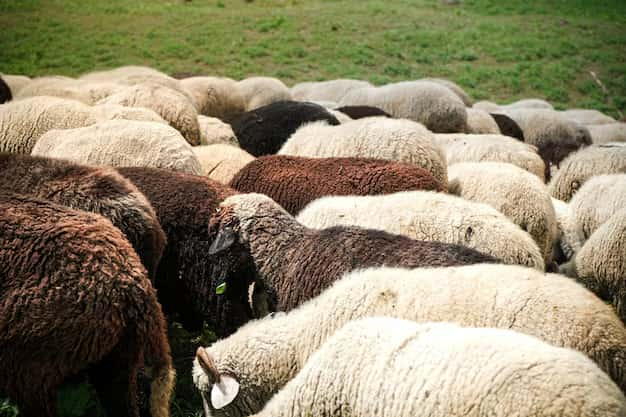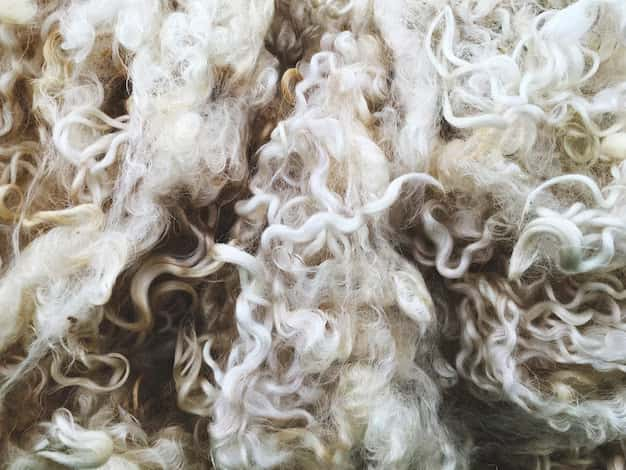Wool, a treasure trove of the animal kingdom, offers more than just warmth and comfort. Its journey from the serene pastures to the bustling markets is a tale of transformation and value creation. The question isn’t just “Can you make money from sheep wool?” but rather, “How much can you earn and how?” This exploration unveils the economic tapestry woven by sheep wool, illustrating its potential as a lucrative commodity.
Understanding Wool Market Dynamics
The wool industry, a vibrant segment of the agricultural economy, is influenced by a myriad of factors. From the breed of sheep to market demands and environmental considerations, each aspect plays a crucial role in determining the value of wool. Notably, the fineness and length of wool fibers are pivotal in dictating market price. Merino wool, renowned for its softness and quality, often commands a premium price.
Breeds and Wool Quality: A Crucial Link
The breed of sheep is intrinsically linked to the quality of wool produced. Breeds like Merino, Corriedale, and Leicester Longwool are celebrated for their superior fleece. Each breed offers unique characteristics, from Merino’s fine fibers to Leicester’s lustrous long wool, influencing both marketability and price.
Comparison of Wool Quality by Breed
| Breed | Fiber Diameter (microns) | Staple Length (cm) | Market Price (per pound) |
|---|---|---|---|
| Merino | 18-24 | 7-10 | $6 – $10 |
| Corriedale | 25-30 | 8-15 | $4 – $7 |
| Leicester | 32-38 | 12-20 | $3 – $5 |
The Economics of Sheep Wool Farming
Comprehensive Farm Management
Sheep wool farming transcends the simple act of shearing and selling. It’s an intricate ballet of various activities, each contributing to the final yield and quality of the wool. Key elements of sheep farming include:
- Breeding: Selecting the right breed is crucial. Breeds like Merino or Rambouillet are known for high-quality wool, but they might require more care and better grazing conditions;
- Feeding: Nutrition plays a pivotal role in wool quality. Balanced diets ensure healthier sheep and better fleece;
- Healthcare: Regular veterinary check-ups and vaccinations are essential to prevent diseases that can affect wool quality.
Financial Aspects
Understanding the financial dynamics is essential for a profitable venture:
- Initial Investment: This includes acquiring land, purchasing a flock, and setting up necessary infrastructure like fencing and shearing sheds;
- Recurring Expenses: These include costs for feed, regular veterinary care, and shearing equipment maintenance;
- Revenue Streams: Apart from selling wool, other revenue streams can include breeding programs, sale of lambs, and agro-tourism if the farm is accessible to visitors.

Innovative Approaches to Enhancing Wool Value
Diversifying Wool Products
Moving beyond selling raw wool opens up new avenues for increased revenue:
- Hand-spun Yarns: There’s a growing market for hand-spun, artisanal yarns, especially among hobbyists and small-scale designers;
- Artisanal Crafts: Wool can be transformed into various crafts like felted sculptures or woven tapestries, appealing to the art market;
- Woolen Apparel: High-quality wool can be used to create niche apparel items, from sweaters to caps, catering to fashion-conscious consumers.
Tapping into Sustainable Practices
Embracing sustainable and eco-friendly practices can significantly enhance the wool’s market value. Organic wool, free from synthetic chemicals, is gaining popularity among eco-conscious consumers.
Global Wool Market Trends and Opportunities: Riding the Wave of Ethical Fashion
The wool industry is currently undergoing a significant transformation, largely influenced by the rise of ethical fashion. This shift has led to an increased demand for wool produced through organic farming practices. As consumers become more environmentally conscious, they are not only interested in the quality of the wool but also in the sustainability of its sourcing and processing methods. This evolving landscape requires wool producers to stay agile and informed about changing fashion trends, consumer preferences, and the growing importance of sustainable materials.
Wool as a Diverse Product: Beyond Textiles
Wool’s applicability extends far beyond the confines of the fashion industry, showcasing its remarkable versatility. One of its notable uses is in insulation, where wool serves as a sustainable and effective alternative to synthetic insulation materials. In the realm of horticulture, wool has found its place as a natural weed suppressant and soil enhancer, demonstrating its ecological benefits. Moreover, wool’s natural absorbency has been capitalized in environmental clean-up efforts, particularly in oil spill clean-ups, showcasing its utility in unexpected yet critical areas.
Creating New Revenue Streams
By exploring these non-traditional applications of wool, producers can unlock new and lucrative markets. This diversification strategy not only broadens the income sources for wool producers but also reduces their reliance on the traditional wool markets. In doing so, they can create a more resilient and versatile business model that can withstand market fluctuations and tap into new consumer segments.
Maximizing Profits through Direct Marketing and Online Sales: Leveraging the Digital Marketplace
The digital era has brought about a revolutionary change in how products are marketed and sold. For wool producers, embracing online sales and direct marketing strategies presents a valuable opportunity. By selling directly to consumers through online platforms, producers can eliminate the need for intermediaries, thereby significantly boosting their profit margins. Moreover, establishing a strong online presence and brand identity is crucial in attracting a global customer base. This direct engagement with consumers not only fosters brand loyalty but also provides valuable insights into market needs and trends, enabling producers to quickly adapt and stay ahead in a competitive marketplace. Through these strategies, wool producers can maximize their profits and establish a strong foothold in the global market.

What To Do With 3 Acres Of Land: Opportunities in Wool Farming
When considering what to do with 3 acres of land, venturing into wool farming presents a unique and potentially profitable opportunity, especially when aligned with the trends and practices of the global wool market. This size of land offers ample space for a small but efficient sheep farming operation, allowing for sustainable farming practices and a personal approach to animal welfare – key factors in the ethical fashion movement.
Setting Up a Small-Scale Wool Farm
On three acres, you can establish a small flock of sheep, ensuring that each animal has enough grazing space to promote their health and well-being. This aligns with the growing consumer demand for ethically sourced and organically produced wool. Breeds like Merino or Rambouillet, known for their high-quality wool, can be a good choice for such a setup. With careful planning, this land can also accommodate necessary infrastructure like a barn for shearing and storing wool, as well as basic shelter for the sheep.
Integrating Wool Farming with Other Sustainable Practices
This land size also allows for the integration of sustainable practices, which can enhance the appeal of the wool in the market. Practices include:
- Rotational Grazing: This method improves pasture health and subsequently the quality of the wool;
- Organic Feed Cultivation: Growing supplemental feed on the land ensures a controlled, organic diet for the sheep;
- Sustainable Resource Management: Efficient water and land management practices to enhance sustainability.
Direct Marketing and Niche Products
With a small-scale operation, direct marketing becomes a highly viable strategy. Opportunities include:
- Artisanal Wool Products: Creating hand-spun yarns, felting kits, or small batches of woolen apparel;
- Online Sales Platforms: Utilizing e-commerce to reach a wider market;
- Brand Storytelling: Emphasizing the sustainability and artisanal quality of the wool in marketing efforts.
Community Engagement and Agro-Tourism
Such a farm can also engage in community and agro-tourism activities:
- Educational Workshops: Hosting sessions on wool processing, sheep care, and sustainable farming practices;
- Farm Tours: Offering tours of the farm to showcase the wool production process;
- Local Community Events: Participating in local markets and community events to build brand recognition.
Conclusion
Sheep wool, a seemingly humble product, holds immense potential for profitability. The key to unlocking this potential lies in understanding market dynamics, exploring innovative avenues, and aligning with global trends. The journey of wool from fleece to fortune is not only feasible but can be profoundly profitable.